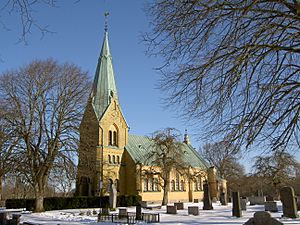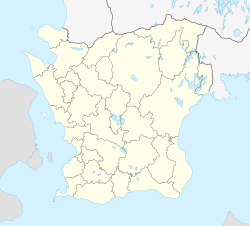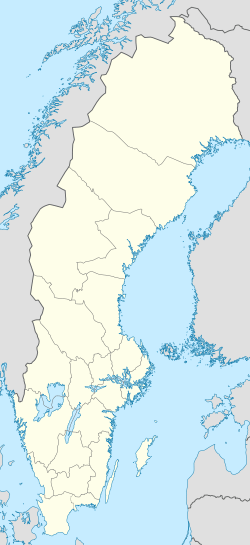Skånes-Fagerhult facts for kids
Quick facts for kids
Skånes-Fagerhult
|
|
|---|---|

Skånes-Fagerhult Church
|
|
| Country | Sweden |
| Province | Skåne |
| County | Skåne County |
| Municipality | Örkelljunga Municipality |
| Area | |
| • Total | 1.64 km2 (0.63 sq mi) |
| Population
(31 December 2010)
|
|
| • Total | 856 |
| • Density | 521/km2 (1,350/sq mi) |
| Time zone | UTC+1 (CET) |
| • Summer (DST) | UTC+2 (CEST) |
Skånes-Fagerhult is a small community, also known as a locality, located in the southern part of Sweden. It is found within the Örkelljunga Municipality in Skåne County. In 2010, about 856 people lived there.
Contents
What is Skånes-Fagerhult?
Skånes-Fagerhult is a "locality" in Sweden. This means it's a built-up area with a certain number of people living close together. It's not a big city, but it's a recognized community.
Where is Skånes-Fagerhult Located?
Skånes-Fagerhult is in Skåne County, which is the southernmost county in Sweden. Skåne is known for its flat, fertile lands and beautiful coastline. The community is part of Örkelljunga Municipality, a local government area.
Understanding Municipalities in Sweden
A municipality is like a local government area. It manages things such as schools, roads, and public services for the people living there. Örkelljunga Municipality looks after the needs of Skånes-Fagerhult and other nearby communities.
Population and Size
In 2010, Skånes-Fagerhult had 856 residents. The area it covers is about 1.64 square kilometers. This makes it a relatively small and close-knit community.
How Does Population Density Work?
The population density of Skånes-Fagerhult was about 521 people per square kilometer. This number tells us how many people live in each square kilometer of land. It helps us understand how crowded or spread out a place is.
Time Zone Information
Skånes-Fagerhult follows Central European Time (CET). This is the standard time zone for many countries in Europe. During the summer, they switch to Central European Summer Time (CEST). This is also known as Daylight Saving Time.
Why Do We Have Different Time Zones?
Time zones help us keep track of time consistently around the world. They are based on the Earth's rotation and how sunlight hits different areas. Daylight Saving Time helps make better use of daylight during the warmer months.



